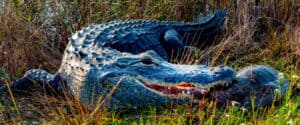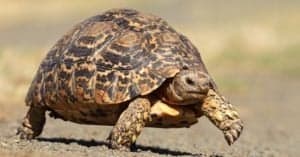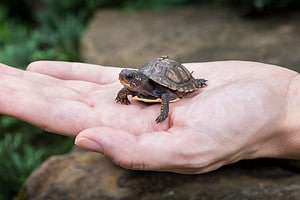Did you know there are 360 species of turtles? You may be biased, like we are, and think all turtles are cute. In any case, here are ten of the cutest turtles in the world.
Turtles are reptiles that have one very unique characteristic. They grow a shell! Turtle shells are made mostly of bone, and the outer surface is covered in scales made of keratin. Some turtles have soft shells that are not made of bone. Some turtles live in freshwater, some love the ocean, and some live on land. Turtles are cold-blooded, so their body temperature is affected by their environment.
Most turtles are omnivores and eat various foods, including plants, mollusks, worms, and insects. Turtles that live on land tend to eat more plants, and turtles that live in the water rely more heavily on meat for their food. In this article, we will go over many more interesting facts about these cute turtles. Let’s get started!
1. Mississippi Map Turtle (Graptemys pseudogeographica kohni)
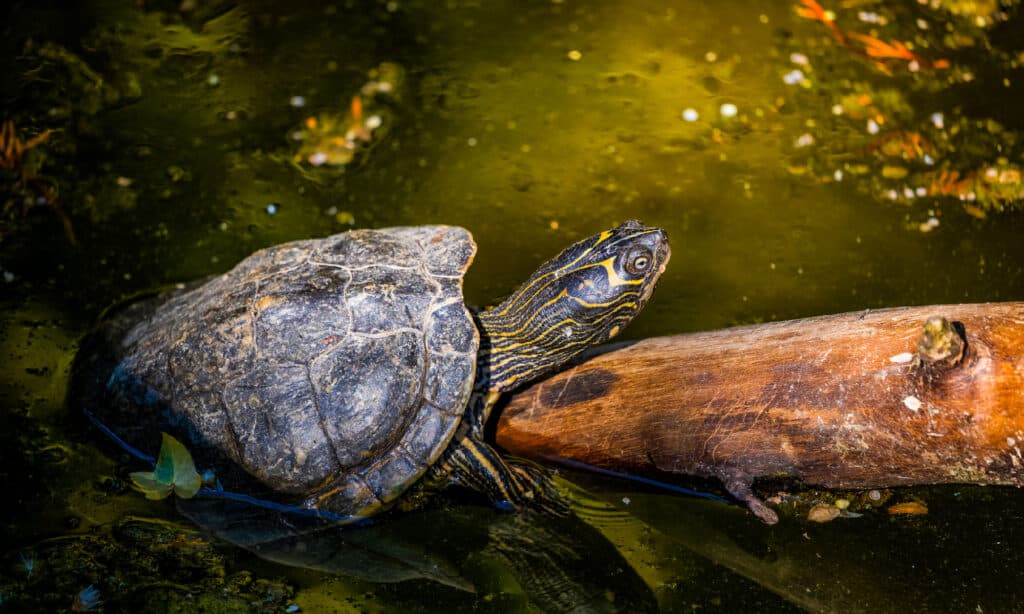
Mississippi
map turtles like to live in areas that have both land and water.
©iStock.com/Artur Bogacki
The Mississippi map turtle is a land and water turtle that gets its name from the Mississippi River. It was named by the naturalist Joseph G. Kohn in the 19th century. And it is definitely a cutie!
This adorable turtle has a grey shell covered in yellow lines. They aren’t very big turtles and only reach a maximum size of ten inches. They live for a really long time, so if you plan to keep one as a pet, prepare for a 20-year commitment.
Mississippi map turtles like to live in areas that have both land and water. In nature, they live in fallen trees that have fallen on the shore of the river.
Mississippi map turtles eat a mixture of vegetables, grasses, snails, clams, insects, worms, and fish. They are threatened by the loss of nesting sites, pollution, and being caught in fishing nets.
2. The Painted Turtle (Chrysemys picta)

The
painted turtle
grows to a maximum diameter of ten inches and has a lovely dark-colored shell that is smooth with no ridges.
©KARI K/Shutterstock.com
This cute turtle is very widespread, living all over North America, from Canada to Mexico. They are freshwater turtles that prefer to make their home in wetland areas. The fossil record shows that painted turtles lived 15 million years ago!
The painted turtle grows to a maximum diameter of ten inches and has a lovely dark-colored shell that is smooth with no ridges. Its skin can be olive or black. Its stripes can be orange, yellow, or red.
Painted turtles eat a variety of foods, including algae, plant material, insects, crustaceans, and fish. Because they are warm-blooded, they prefer to venture out and hunt during the warmest parts of the day. You may have seen one of these cute turtles basking on a log in the sun. Painted turtles hibernate in the mud during the winter and come out when the weather is warm enough in the spring.
Painted turtles used to be a very popular pet, but recent legislation is discouraging this practice as it is not in the animal’s best interest or the environment. Painted turtles require a large enclosure with a filter that is changed often and a basking site. They do not like being touched, and they live for 40 years.
3. Florida box turtle (Terrapene carolina bauri)
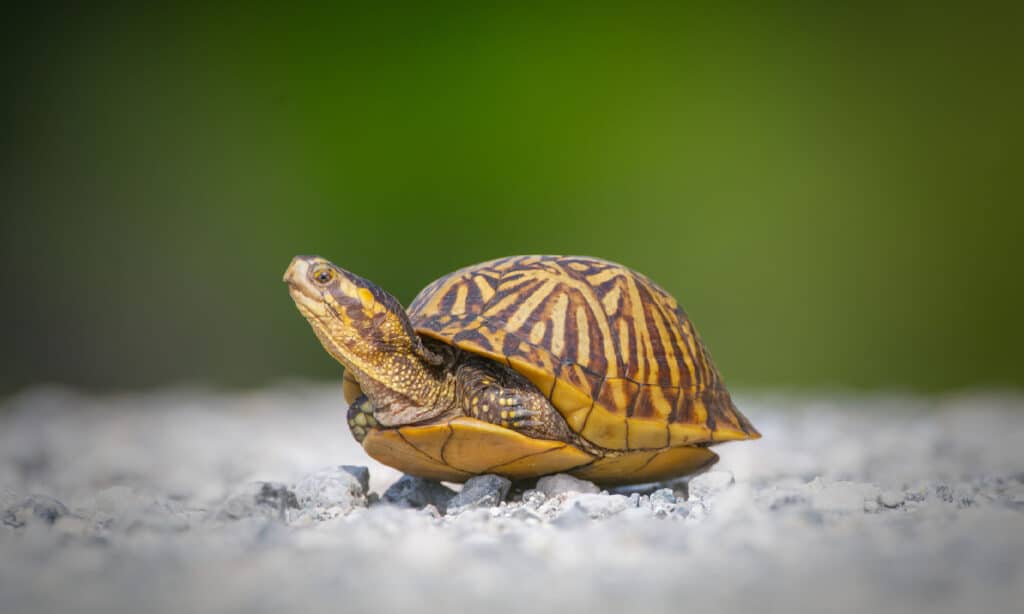
Florida
box turtles
spend the majority of their lives snuggled in underbrush or even under the ground.
©iStock.com/Dan Rieck
Florida box turtles live in wetlands, like marshes and swamps. They are not a fan of deep water and prefer to remain on land much of the time. They love basking in the sun, especially when the temperatures are over 80°F. They spend most of their lives snuggled in the underbrush or under the ground.
They are certainly cute, with a beautiful domed shell and a unique pattern of yellow stripes. They reach about seven inches in diameter, with females slightly smaller than males. Their favorite foods are insects, fruits, herbs, grasses, vegetables, and mushrooms. They are important members of the ecosystem because they help spread the seeds of plants around their habitat, especially fruit seeds.
Florida box turtles are ready to mate once they are 13 years old. They lay between one and nine eggs in each clutch. Reproduction is most successful in years with more precipitation. Scientists are carefully studying the effects of climate change and drier environments on their populations.
4. Red-Eared Slider (Trachemys scripta elegans)
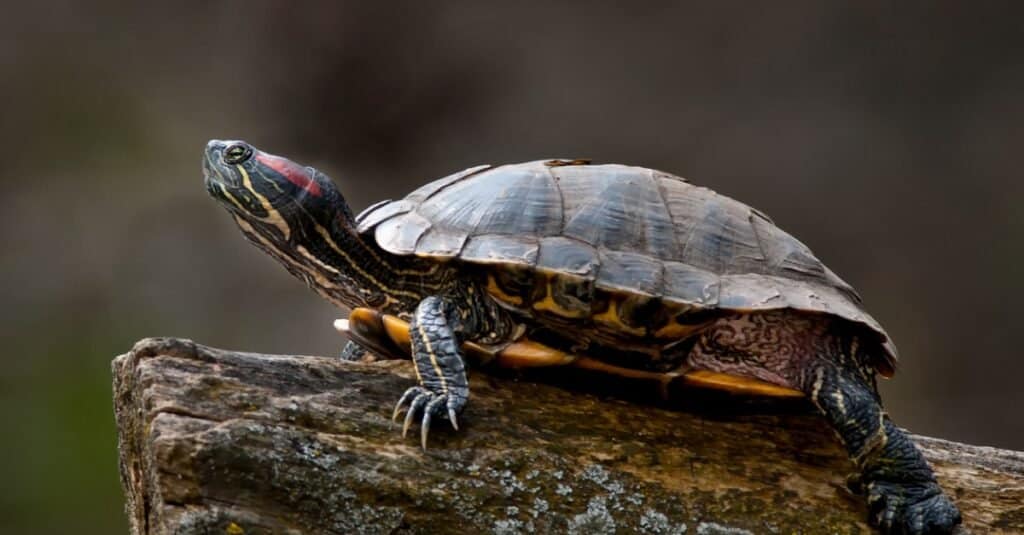
The most distinctive characteristic of the
red-eared slider
is the bright red stripe behind the eyes.
©iStock.com/PaulReevesPhotography
This cute turtle is very popular; for a good reason, they have a dark green shell that gets darker as they age. Their underbelly is yellow, and their legs, head, and tail are light green. They are covered in stripes and markings that help them stay camouflaged in the wild. And don’t forget the cute red strip on each side of their heads! Red-eared sliders live for up to 30 years and stay under twelve inches in size.
Red-eared sliders are native to the Mississippi River and the Gulf of Mexico. Nowadays, they can be found in many warm climates. In some areas, they are considered an invasive species. They prefer to live in still water, like ponds, lakes, and swamps. They eat mostly aquatic plants, so they must live in an area with ample vegetation. They live in or near the water, only venturing away to lay their eggs or look for a new habitat.
5. Northern Red-Bellied Turtle (Pseudemys rubriventris)
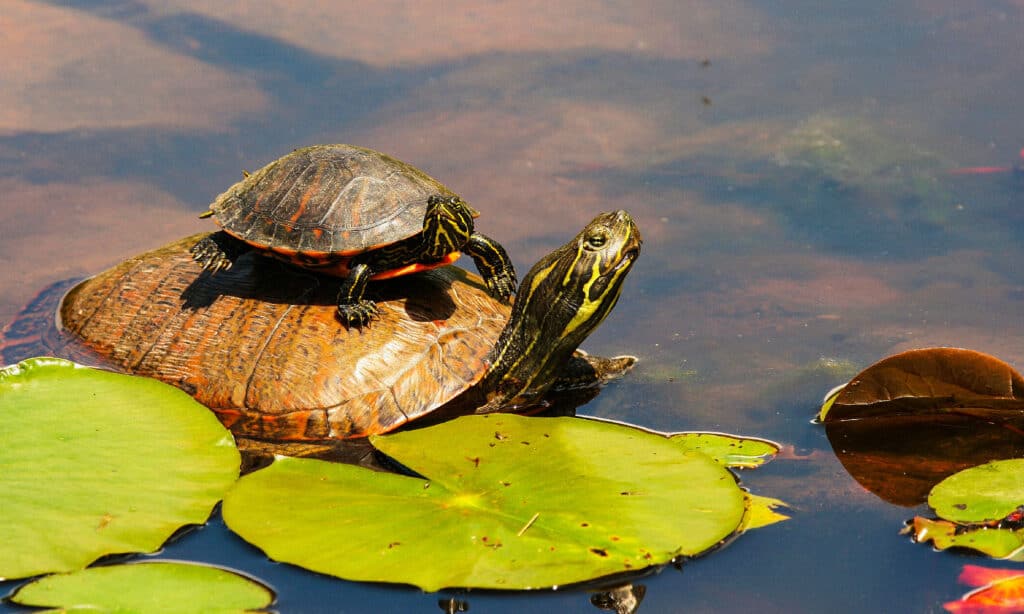
Northern red-bellied cooter lives in rivers, ponds, creeks, and other slow-moving fresh water in the eastern
United States
.
©iStock.com/DavidByronKeener
Also called the American red-bellied turtle and the northern red-bellied cooter, this cute turtle loves to live in rivers. It can reach a maximum size of 12-16 inches in diameter and a weight of nearly seven pounds. Females are larger than males. They have a lovely reddish brown shell covered in orange, yellow, and red stripes.
They live in rivers, ponds, creeks, and other slow-moving fresh water in the eastern United States. They like an area with plenty of basking areas and soft mud to spend the winter. They eat various foods, like most omnivores, including plants, worms, fish, and water lilies.
The red-bellied turtle is threatened by habitat loss, wetland loss, pollution, and overcapturing for pets.
6. Yellow-Bellied Slider (Trachemys scripta scripta)
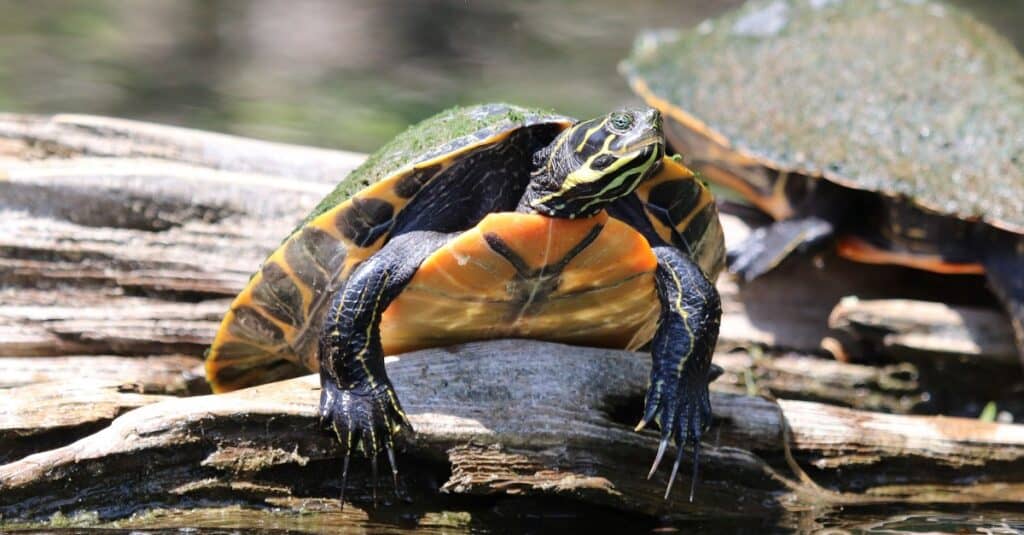
Yellow-bellied sliders have a brown or green shell with yellow on its underside.
©iStock.com/jrubacha
This cute turtle lives up to its name with a yellow underside and a blackish-brown upper shell. They have beautiful green skin, yellow stripes, and patches of green and yellow on their neck and legs. Adults tend to grow darker as they age. This species often has unique question-mark-shaped markings on their bellies. They reach a diameter of five to nine inches and live for up to 40 years.
Yellow-bellied sliders can be found in the southeastern side of the United States. They are land and water turtles that live in swamps, marshes, and wetlands. If their area dries up, they will travel to find a new, wetter habitat. They eat a variety of vegetables, insects, and fish. They are most active in the early morning and can be seen on shore or basking on floating logs the rest of the day. They sleep at night under brush piles or lily pads.
Yellow-bellied sliders are threatened by pollution, loss of habitat, climate change causing their habitats to dry up, and loss of nesting sites.
7. Eastern Mud Turtle (Kinosternon subrubrum)
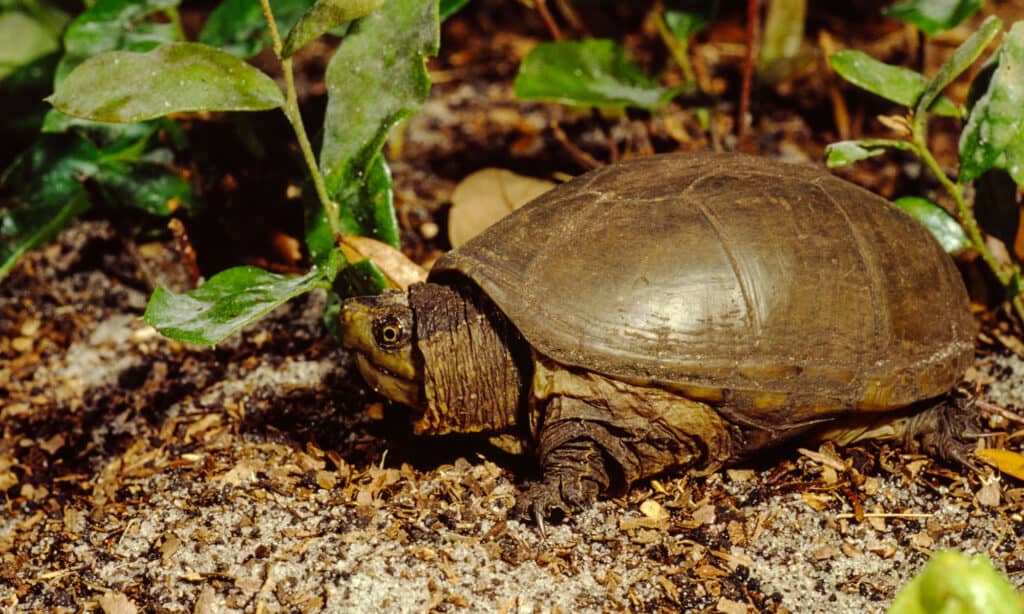
They prefer oxygenated water that is moving rather than stagnant, but they can adapt to living in still water, such as marshes and swamps.
©Liz Weber/Shutterstock.com
Eastern mud turtles are pretty cute, reaching only four inches in size. They have a shell with no pattern that varies in shades of yellow, brown, and black. They have yellow chins, and their legs and tail are gray.
Mud turtles species are found in the United States, Mexico, and Central and South America. The Eastern mud turtle (Kinosternon subrubrum) is native to the United States. They can be found in rivers and lakes as long as there is enough vegetation. They prefer oxygenated water that is moving rather than stagnant, but they can adapt to living in still water, such as marshes and swamps.
Mud turtles eat invertebrates, fish, and mollusks. They also eat aquatic vegetation, algae, insects, and amphibians.
Eastern mud turtles are threatened by habitat loss, vehicle traffic, and pesticides.
8. Eastern Box Turtle (Terrapene carolina carolina)
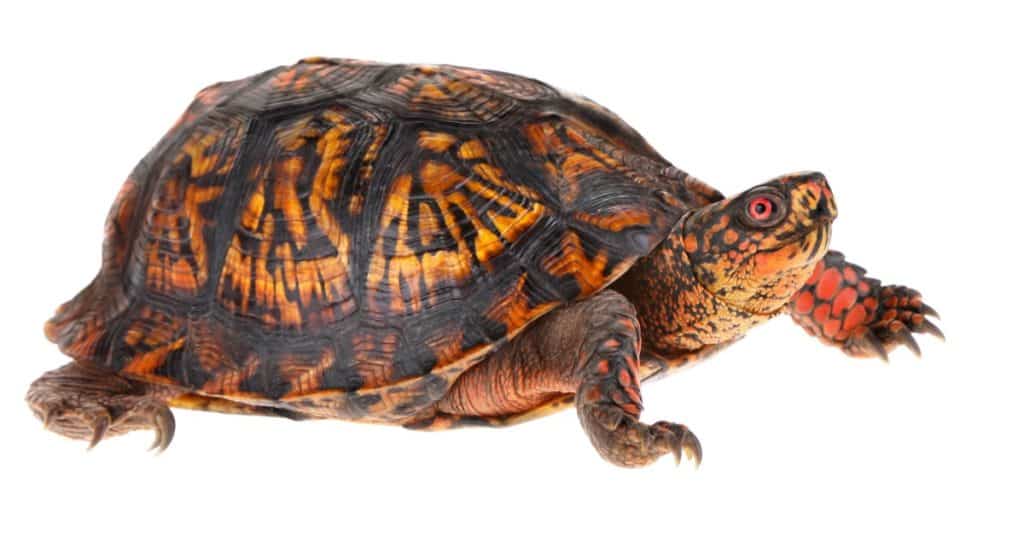
Eastern box turtles
are very cute, with domed shells and beautiful coloration.
©Studio DMM Photography, Designs & Art/Shutterstock.com
This type of box turtle is native to the eastern part of the United States. It is a pond turtle and makes its home in deciduous forests with a pond or shallow stream nearby. They have also been spotted in open grasslands and pastures, as long as they have a way to keep moist. However, they do not like deep water and can drown if completely submerged. They are one of the few reptiles that stay in the same home area for a long period, sometimes their entire lives.
Eastern box turtles are very cute, with domed shells and beautiful coloration. They range in color from yellow to orange and red and are covered in spots and streaks. They reach a diameter of five or six inches and can live for 25 to 100 years.
Eastern box turtles eat a wide variety of foods depending on their environment. They eat earthworms, snails, slugs, grass, fruit, berries, mushrooms, flowers, caterpillars, and grubs.
Eastern box turtles are threatened by habitat loss and climate change.
9. Hawksbill Sea Turtle (Eretmochelys imbricata)
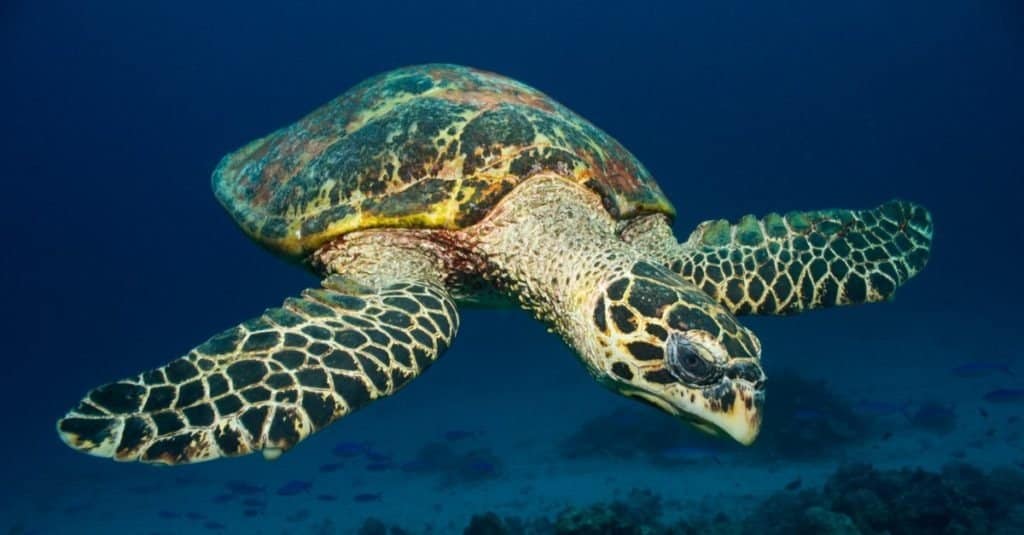
The Hawksbill turtle can grow up to three feet long and weighs an average of 180 pounds.
©John Back/Shutterstock.com
This turtle is definitely cute, with a flattened shell to help it swim easily and flipper-shaped legs, each with its own claw. It has a curved beak like a hawk, and its shell changes colors when the water temperature changes. The Hawksbill turtle can grow up to three feet long and weighs an average of 180 pounds. The biggest one ever recorded weighed 280 pounds! They have a lovely amber-colored shell covered in streaks and stripes of varying shades of brown. The hawksbill sea turtle is one of the few reptiles that are biofluorescent. This is probably due to its steady diet of biofluorescent coral. They primarily eat sea sponges, algae, and marine plants. They have been known to consume jellyfish, sea anemones, fish, and mollusks.
The lifespan of the hawksbill sea turtle is unknown because they are solitary creatures and difficult to study. They are often killed by humans, both accidentally and on purpose. They are also threatened by the loss of nesting areas and pollution. They are currently listed as a Critically Endangered Species by IUCN.
10. Leatherback Sea Turtle (Dermochelys coriacea)

The
leatherback sea turtle
can weigh up to 1,100 pounds. It does not have a bony shell but rather leather-like skin and oily flexible flesh.
©iStock.com/YasserBadr_Beenthere
This turtle is also called the lute turtle and the leathery turtle. It is extremely cute and large, coming in at an amazing five to six feet in length. The leatherback sea turtle can weigh up to 1,100 pounds. It does not have a bony shell but rather leather-like skin and oily flexible flesh. They are tear-drop shaped and made for swimming through the water quickly with giant front flippers. It is a dark gray or black color with white speckles.
The leatherback sea turtle lives up to its name and makes its home in the sea. It has a widespread habitat with species found in the Atlantic and Pacific oceans. There is believed to be a population living in the Indian Ocean, but they have yet to be studied extensively.
The leatherback sea turtle’s favorite food is jellyfish. In fact, these turtles are one of the main reasons that jellyfish populations don’t get out of control. They also eat fish, sea urchins, and snails when hungry.
These cute turtles are threatened by many things, mainly trash in the sea that they mistake for jellyfish and eat, and they are accidentally caught in fishing nets.
10 Cute Turtle Facts
- Turtles are not mute. They make a variety of noises to communicate!
- A turtle’s shell is sensitive to touch. There are nerves in the shell helping the turtle to feel even light touches, so be careful!
- Most turtles are mostly carnivorous when young and more herbivorous as adults.
- Not all turtles have hard boney shells.
- Hawksbill turtles use their beaks to reach inside holes and find food.
- Leatherback sea turtles swim more than 10,000 miles per year.
- Sea turtles breathe air but can stay underwater for several hours at a time.
- Turtles are one of the oldest reptile species. Older than snakes, crocodiles, and alligators. They lived 200 million years ago!
- Some turtles can tuck their heads into their shells for protection, and some can’t.
- Turtles can’t take off their shell. It grows out of their rib cage and is part of their skeleton.
Here is a Summary of the 10 Cutest Turtles in the World
- Mississippi Map Turtle
- Painted Turtle
- Florida Box Turtle
- Red-Eared Slider
- Northern Red-Bellied Turtle
- Yellow Bellied Slider
- Eastern Mud Turtle
- Eastern Box Turtle
- Hawksbill Sea Turtle
- Leatherback Sea Turtle
Next Up
- Snapping Turtle
- Cute But Deadly: The 10 Most Vicious Animals That Look Cute!
- The 10 Dogs With The Biggest Ears (So Cute!)
The photo featured at the top of this post is © iStock.com/Dan Rieck
Sources
- Springer Nature, Available here: https://link.springer.com/article/10.1007/s11252-010-0125-8
- ResearchGate, Available here: https://www.researchgate.net/publication/322603199_Clutch_Size_and_Frequency_in_Florida_Box_Turtles_Terrapene_carolina_bauri_Implications_for_Conservation
- National Library of Medicine, Available here: https://www.ncbi.nlm.nih.gov/pmc/articles/PMC3960240/
- U.S. Department of Health and Human Services, Available here: https://www.accessdata.fda.gov/scripts/cdrh/cfdocs/cfcfr/cfrsearch.cfm?fr=1240.62
- Oregon Department of Fish and Wildlife, Available here: https://www.dfw.state.or.us//conservationstrategy/docs/TurtleIDCardFRONT.pdf
Thank you for reading! Have some feedback for us? Contact the AZ Animals editorial team.



